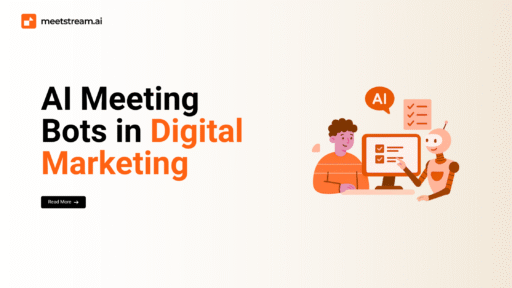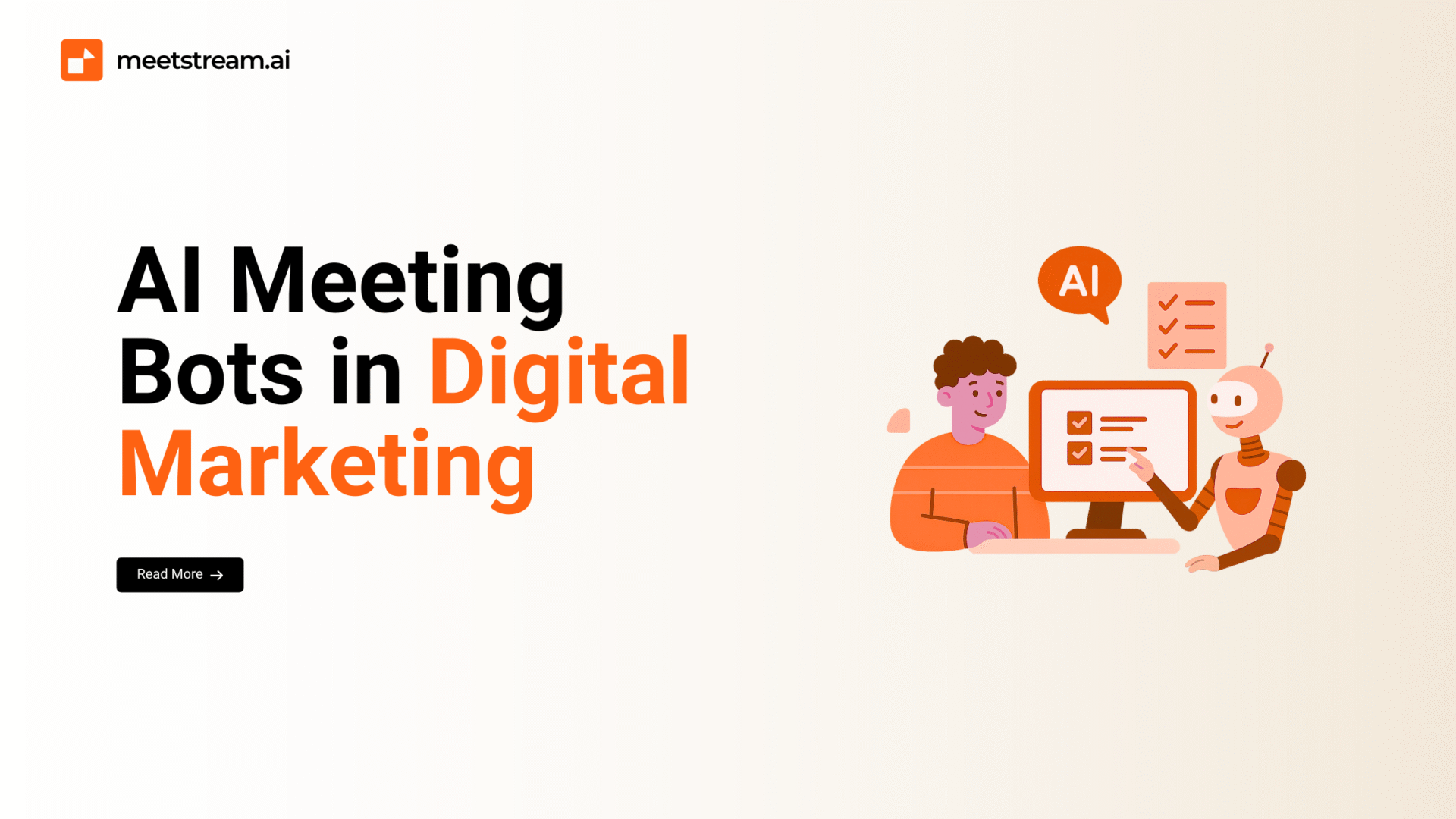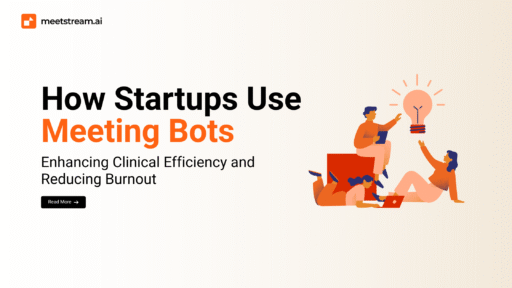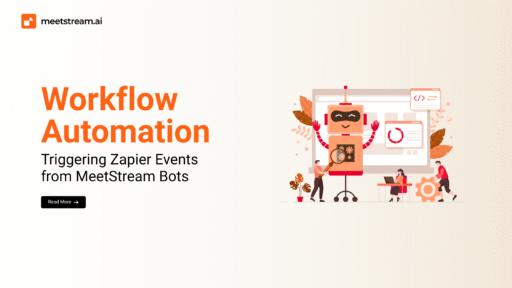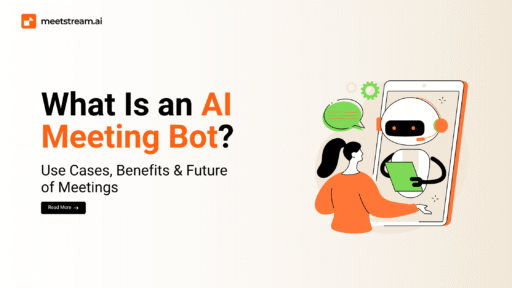Modern marketing teams operate at breakneck speed. They juggle content calendars, campaign launches, social rollouts, and executive check-ins, often all in the same day.
Collaboration fuels these efforts, with meetings playing a central role. But high-volume, fast-paced meetings come at a cost—missed details, disorganized follow-ups, and time lost to manual admin work.
Creative professionals are constantly switching contexts: bouncing between design tools, strategy sessions, analytics dashboards, and internal updates. Writing notes, remembering deadlines, and tracking decisions shouldn’t slow them down.
That’s where AI meeting bots make all the difference. These digital assistants join meetings automatically, transcribe conversations, extract action items, and push insights straight into your workflow.
What Are AI Meeting Bots for Marketing Teams?
AI meeting bots are software-driven agents that assist with every part of the meeting lifecycle. Designed for speed and context, they integrate seamlessly with Zoom, Microsoft Teams, Google Meet, and other conferencing tools.
Once deployed, they automatically attend recurring meetings—be it Monday morning standups, content syncs, or campaign retros—and get to work in the background.
They transcribe every word using speech models trained on marketing lingo, whether you’re talking influencer engagement, email open rates, or TikTok ad spend.
They distinguish who said what through speaker identification and convert insights into organized outputs.
For instance, if a designer commits to a landing page draft by Friday, the bot captures the task and assigns it.
The best bots don’t just record; they understand. Using Natural Language Processing (NLP), they identify dates, KPIs, campaign names, and requests, turning phrases like “We need final assets before launch on August 10” into structured deadlines inside Asana, ClickUp, or Trello.
You get a complete recap, including summaries, action items, and speaker-assigned tasks, all delivered post-meeting.
Key Use Cases of AI Meeting Bots in Marketing
1. Campaign Planning and Briefing
Campaign planning sessions bring creative, strategy, and ops teams together to shape messaging, channels, audiences, and timelines. These fast-paced discussions are often idea-heavy and detail-rich.
AI meeting bots transcribe the meeting in real-time, capturing every idea word-for-word so no one scrambles to take notes. Using NLP, the bot turns discussion points into a structured creative brief complete with campaign goals, visual themes, tone, and audience targeting.
When deadlines are mentioned like “mockups by May 10,” the bot flags and syncs them to project tools like Asana or Trello.
Speaker diarization ensures tasks like “I’ll handle influencer outreach” are assigned to the right person. This eliminates admin work and speeds up campaign execution.
2. Content Strategy Sessions
Content strategy meetings focus on brainstorming blogs, videos, SEO topics, and campaign themes. These creative sessions often generate gold, but ideas can vanish if not recorded instantly.
AI bots act as a second brain, capturing content ideas the moment they’re voiced. When someone suggests, “Let’s do a fintech founder video series,” the bot logs and tags it, ready for the editorial calendar.
It also identifies SEO cues like “We should rank for ‘remote marketing tools,’” and adds them to your CMS or planning docs.
Date mentions like “in Q2” are converted into calendar entries. If an editor commits to a task, the bot schedules and assigns it with no follow-up required.
3. Weekly Marketing Standups
Weekly standups help teams stay aligned on progress, blockers, and sprint goals. But with tight schedules, it’s easy to miss updates or lose context.
AI bots log updates in real time, organizing them into completed tasks, current blockers, and next steps. After the meeting, a summary is automatically shared via Slack or email, complete with assignees and deadlines.
For distributed teams, this recap keeps everyone in sync, especially when someone can’t attend. Bots can also tag updates to specific sprints like “Sprint 12,” helping teams track initiatives with less overhead.
4. Stakeholder and Cross-Team Syncs
Stakeholder meetings include input from product, sales, leadership, and partners. These sessions are high-impact but often dense and difficult to capture manually.
AI bots record key feedback like “Add customer logos to Q3 emails” or “We need this by Tuesday,” tagging speakers and converting comments into tasks. Priority cues like “ASAP” or leadership requests are auto-flagged for urgent follow-up.
Instead of writing recap emails, the bot sends a formatted summary to all stakeholders in Slack or Notion.
When new campaign ideas are shared verbally, the bot drafts creative briefs automatically, saving time and reducing misalignment.
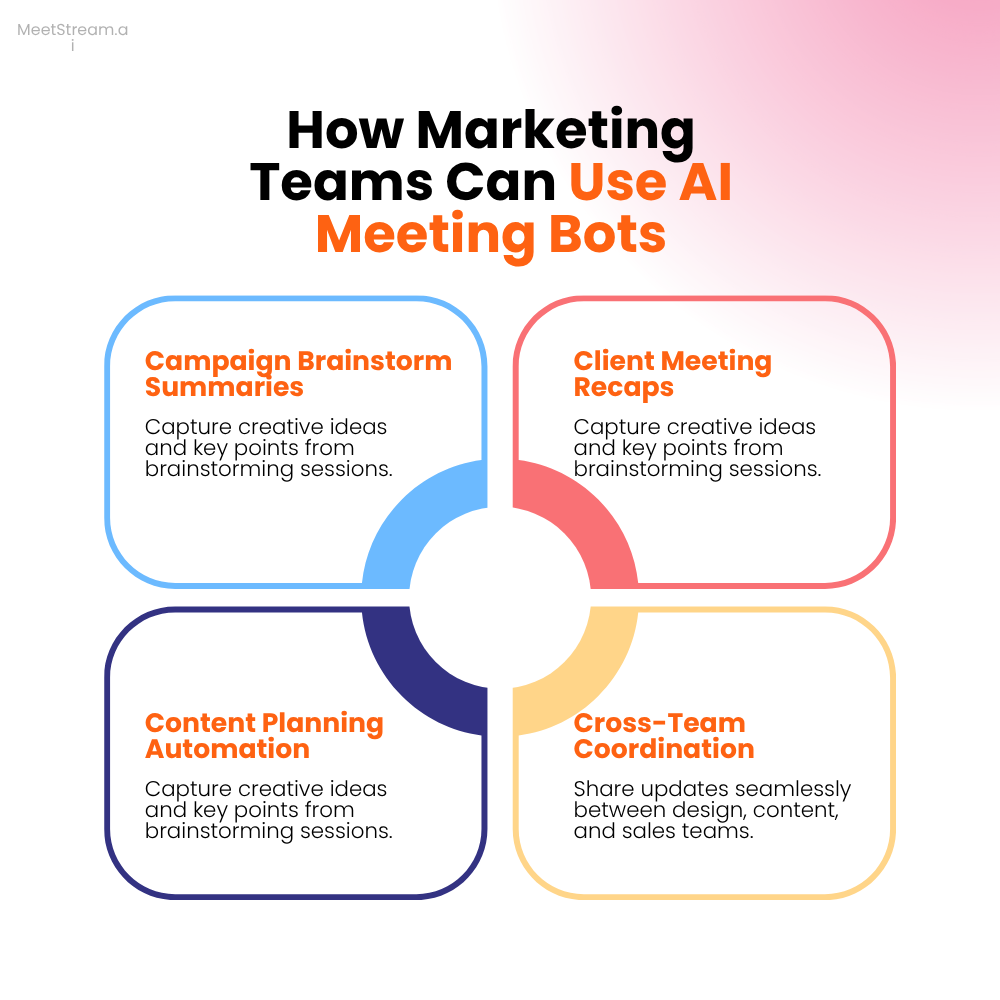
MeetStream.ai: The Backbone of Smart Marketing Meetings
MeetStream.ai powers smarter meetings by automating transcription, summarization, and task extraction. It supports marketing-specific language and integrates across Zoom, Google Meet, and Microsoft Teams.
Its API and webhook triggers let you automate actions like generating briefs or updating campaign dashboards in real time. NLP pulls out KPIs, deadlines, and speaker-based assignments automatically.
Seamless integration with tools like Slack, Trello, HubSpot, ClickUp, and Notion ensures outputs land where your team already works. It’s scalable, intuitive, and built specifically for marketing workflows.
Benefits of AI Meeting Bots for Marketing Teams
AI bots eliminate manual notes and follow-ups, freeing marketers to focus on strategy. Summaries, briefs, and tasks are generated instantly, boosting team productivity.
Creative discussions stay fluid, with spontaneous ideas logged as they happen. Nothing is lost, and ideation becomes action-ready.
Clear, consistent recaps reduce misunderstandings and ensure every team member is aligned. Meetings become launchpads for execution, not bottlenecks.
With speaker attribution, bots assign tasks automatically, building ownership from live discussions. Accountability becomes effortless, and follow-through improves.
Features to Look For in an AI Meeting Bot for Marketing
Choose a bot that offers accurate, real-time transcription tailored to marketing language. Look for multiple summary formats, bullets for quick scans, and paragraphs for documentation.
Speaker diarization ensures tasks go to the right person. NLP should detect actionable items and tag them to the right campaign or sprint.
Make sure the bot integrates natively with your stack Slack, Trello, ClickUp, Notion, HubSpot, and Zapier. It should push summaries directly into your editorial calendar or dashboards.
Recaps should be delivered automatically via Slack, email, or exported as PDFs or Notion pages tagged and ready to share.
Security is essential. Look for admin-controlled access, encrypted storage, opt-in for guests, and audit-ready export logs.
Conclusion
Marketing teams today need more than note-takers. They need smart, seamless assistants that capture the energy of a brainstorm, the clarity of a status update, and the nuance of a client review, without slowing down the creative flow. AI meeting bots deliver that edge.
By embedding tools like MeetStream.ai into your workflow, you eliminate friction, unlock speed, and transform scattered conversations into focused execution. Campaigns get to market faster. Ideas turn into deliverables. And teams operate with clarity and confidence.
Try one in your next meeting and see what your team can accomplish when nothing gets lost in translation.

